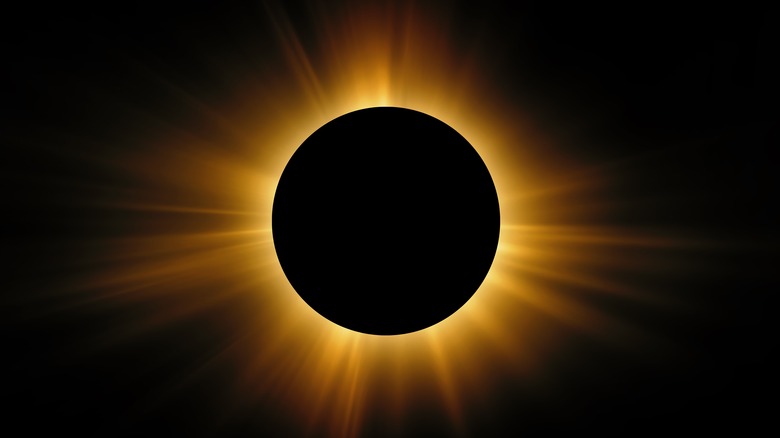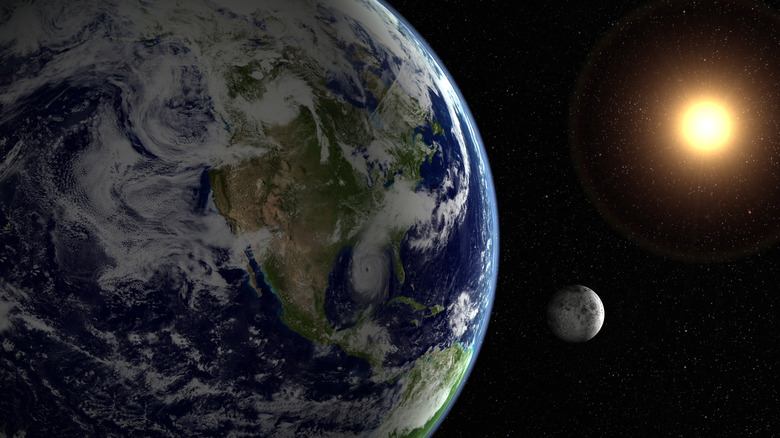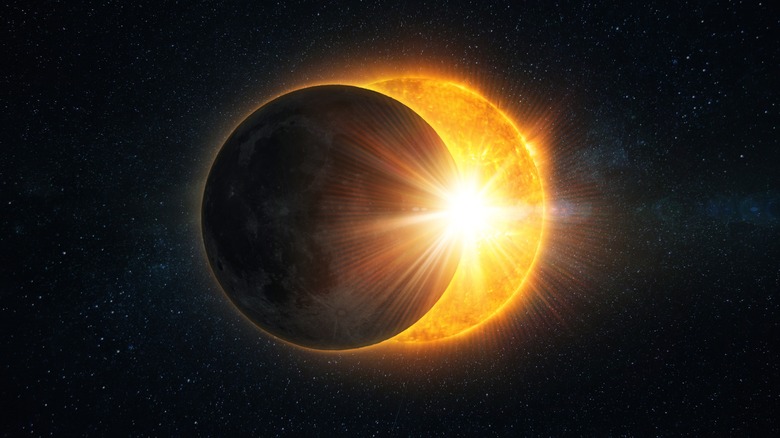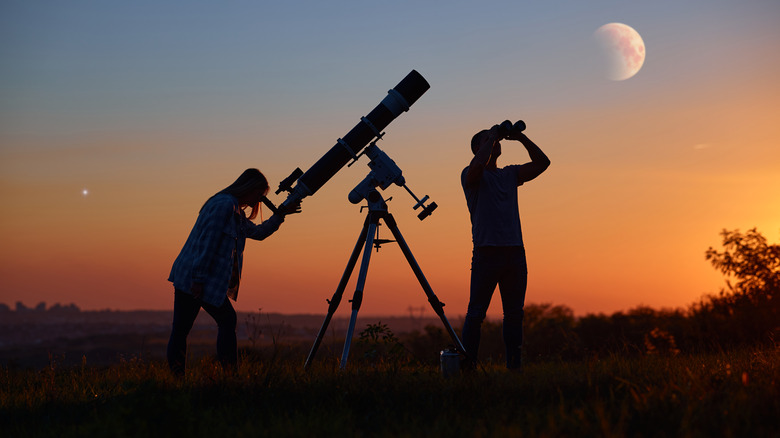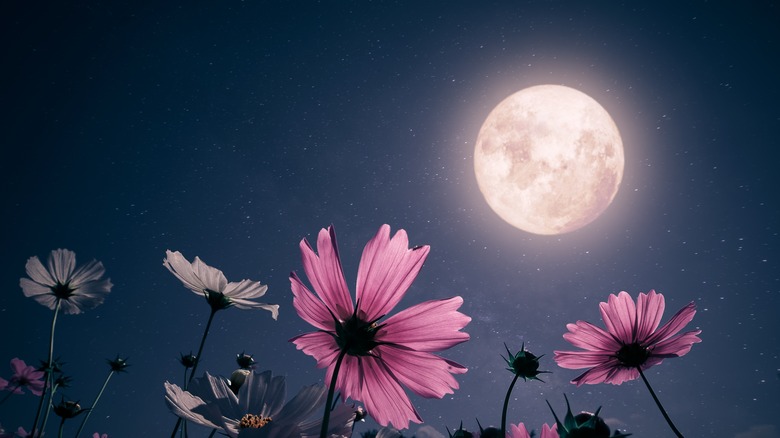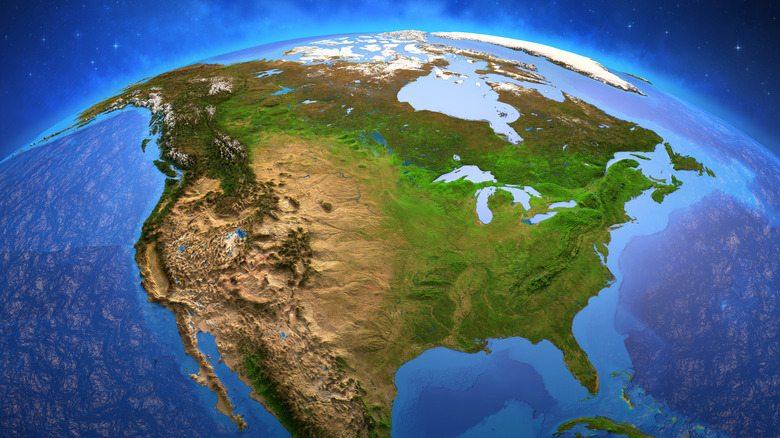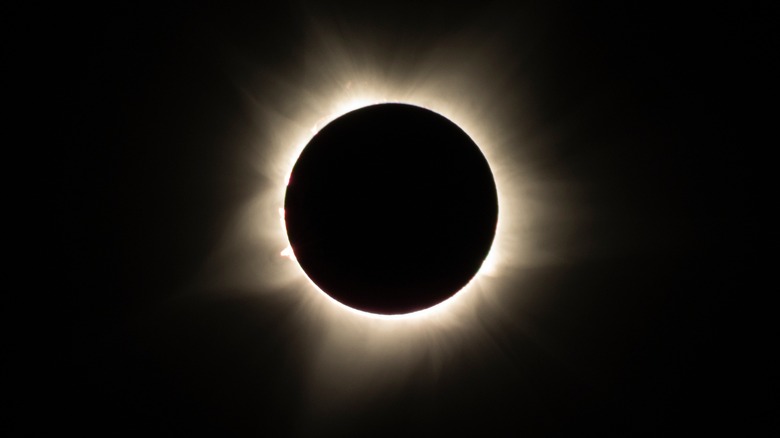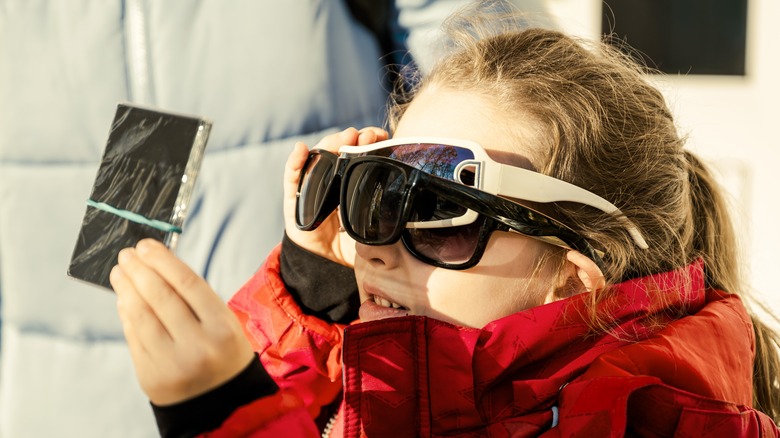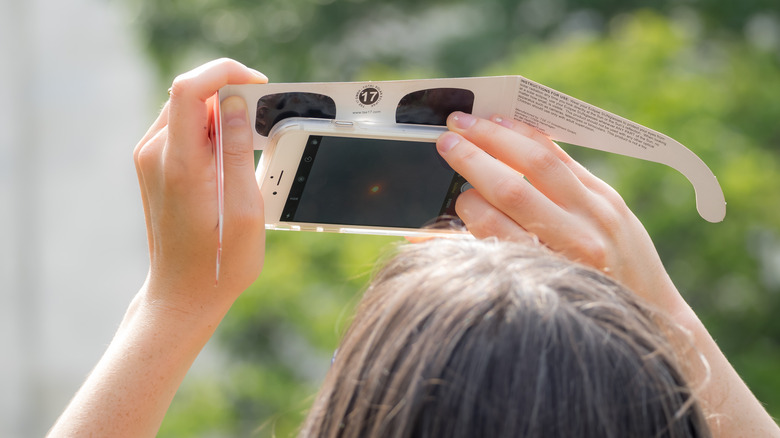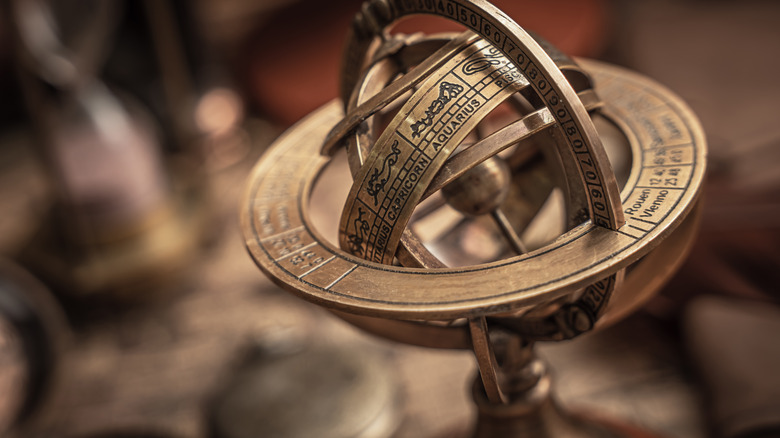Everything You Need To Know About The 2024 Total Eclipse
Every new year brings fresh promises, and at the beginning of 2024, people will be looking forward to whatever highlights the latest trip around the sun has in store for us. A new team will win the Super Bowl. A new movie will be crowned Best Picture at the Oscars. Americans will even choose their next president. The year ahead will surely be full of spectacle, anticipated and unexpected. But, even for those who managed to snag hard-to-get concert tickets or book vacations to choice spots, it's possible that nothing will be so spectacular as the midday sky come this spring ... if you're in the right place at the right time, that is.
That's because, on April 8, 2024, the Earth, sun, and moon promise to put on a show in the way of a particularly event-worthy eclipse. Here's everything you need to know to see it, understand it, and appreciate it for yourself.
A scientific history of eclipses
Today, most people — even those who aren't interested in astronomical phenomena — understand the basic idea of an eclipse. When one celestial body passes in front of another celestial body and obscures visible light in the process, an eclipse takes place. For us here on Earth, those celestial bodies are our sun and our moon. However, the majority of modern humans only grasp the concept of eclipses because of the scientific minds that came before us, and still many of us don't realize just how important eclipses have been to several academic disciplines.
Ancient civilizations as far back as 3340 B.C. observed and recorded eclipses. Between then and now, descriptions of eclipses evolved from petroglyphs and hieroglyphs to passages in religious and historical texts, before finding themselves in the peer-reviewed published results of scientific studies. Throughout human civilization, the documentation of eclipses has helped to shed light on mysteries about the mechanics of our universe. Ancient Chinese inscriptions enabled astronomers to calculate the ever-so-slightly decreasing rate at which the Earth rotates. Eclipses led to early astrophysicist Johannes Kepler's seminal three laws of planetary motion. And famously, they allowed Sir Arthur Eddington to prove that Einstein was onto something with his famed theory of general relativity.
It's not merely the observation of eclipses but the ability to predict them that validates and builds on our understanding of our planet and the cosmos. It prepares us to see the next upcoming eclipse with our own eyes — down to the very minute — and gives scientists the opportunity to keep building on thousands of years of knowledge.
How eclipses are predicted
One early civilization with the resources and skills to predict eclipses appears to have been the Maya, whose codices accurately pinpointed an eclipse that wouldn't occur until many centuries later, in July 1991. They were able to project so far into the future by carefully keeping track of the position of the Earth, sun, and moon throughout the calendar year, and extrapolating future eclipses using fairly basic math. Today, with the immense benefit of computers, eclipse prediction has gotten much more exact, though the basic principles behind it haven't changed much over the millennia.
There are several essential components to the formula. The Earth travels around the sun on an invisible plane called the ecliptic. Every year, the moon crosses that path at two points, or nodes, but calculating the time and date of future eclipses isn't quite as simple as that. First, the moon has to be in the right phase for an eclipse to occur. There are also slight variations in the slant and speed of the movement of the Earth, sun, and moon, not to mention gravitational interference from entities like asteroids, all of which can complicate an eclipse prediction.
Thanks to celestial data collected over thousands of years, scientists can rely on ephemerides — reliable models of where these celestial bodies will be — combined with the two shadows the moon creates on the Earth (termed the umbra and penumbra) to help them solve for the date, time, place, and type of eclipses that will be visible with incredible precision.
Types of eclipses
The Earth, sun, and moon can align themselves so as to produce two primary types of eclipses: lunar and solar. Lunar eclipses, which only occur when there's a full moon, are the result of the Earth directly blocking the sun's rays from reaching the moon. The effect is often that the moon appears darker and reddish in hue. Lunar eclipses can be total (when the Earth completely shades the moon), partial (when a portion of the moon is blacked out by the Earth, creating a bite-like effect), or penumbral (when the moon only passes through only the outer shadow of the Earth, which results in a less noticeable eclipse). A penumbral lunar eclipse is predicted for March 25, 2024.
But the more exciting cosmic show will take place shortly thereafter. Solar eclipses only occur when a new moon passes in between the Earth and the sun, and like lunar eclipses, there are multiple subcategories of solar eclipses: total (in which the moon completely shades the sun), annular (when the moon is too far from Earth to block the whole sun completely but still appears to create a large, dark circle on its surface), partial (in which a slightly misaligned moon and sun make our star temporarily look like a crescent), and hybrid (a cross between total and annular, depending on the viewing location and the curvature of the Earth).
The solar eclipse in April 2024 will be a total eclipse, and a spectacular and rare one at that.
How often eclipses occur
Just how rare are eclipses? On the whole, not very. Because of the rotations and orbits of the Earth, sun, and moon, there are necessarily between two and five solar eclipses every year, with the average being 2.38. That means years with the minimum number of two eclipses are much more common than years with more. In fact, by using the prior observations and projection models, we know that only one-half of one percent of years have five solar eclipses, while nearly three-quarters of years have two. Lunar eclipses, on the other hand, happen somewhat more regularly; the physics dictates that there are between one and three in any given year, with three being closer to the norm.
That might make it seem like witnessing an eclipse isn't exactly a once-in-a-lifetime event. However, the odds are that most people will only have the chance to see a total solar eclipse maybe once or twice in the course of a normal lifespan ... if they're lucky or willing to travel. The alignment of the Earth, sun, and moon follows a roughly 18-year cycle (called the Saros cycle), which means that similar eclipses can be expected to occur about every 18 years. However, not every eclipse is a total eclipse.
For a specific geographical location, the chance to experience totality happens only once every 375 years on average. You're better positioned if you find yourself in the Northern Hemisphere, where it's more like every 330 years. And for those in the Southern Hemisphere? It's a once-every-540-year phenomenon.
When to expect the next total solar eclipse
Thankfully, in early 2024, some of Earth's citizens won't have to wait 18, 330, or even 540 years to see the next total solar eclipse. For those who reside in or plan to visit North America, one is just around the corner. On the afternoon of Monday, April 8, 2024, beginning at about 11:07 a.m. Pacific Daylight Time, and ending at about 5:16 p.m. Newfoundland Daylight Time, a total solar eclipse will be visible to a large swath of the continent.
After April 2024, the United States won't experience another total solar eclipse for more than 20 years, so interested skywatchers who are within a reasonable distance of the path of totality should probably make arrangements to participate. Another total solar eclipse will occur on August 23, 2044, and, fortunately, anyone who misses out on that totality will have a second chance on August 12, 2045 ... just a little less than a year later.
The path of totality
Only a tiny fraction of people on the Earth's surface are within the path of totality during any solar eclipse. So, to be able to look up into the daytime sky and see the sun all but disappear requires extraordinary luck — or a lot of advanced planning. On April 8, 2024, while about 635 million people in North America will be able to view the eclipse in some capacity, only 43 million are in the path of totality ... a narrow band across North America that starts on the Pacific Coast of Mexico and ends on the Atlantic side of Canada. Anyone within an average of 115 miles of that trajectory should be able to see the eclipse as a true totality.
Several municipalities, plus state and National Parks, happen to lay within that path's range for anyone who's interested in putting the total solar eclipse on their schedule. These include cities like Dallas, Texas; Little Rock, Arkansas; Cleveland, Ohio; Erie, Pennsylvania; Buffalo, New York; and Burlington, Vermont, as well as Niagara Falls, Cuyahoga Valley National Park, Hot Springs National Park, and the Adirondack Mountains.
But eager eclipse hunters should take note: totality will begin and conclude at different times for different locations. Sites in the Southwest will see the sky darken first, and the path of the April 8 total solar eclipse will proceed toward the Northeast thereafter.
What makes this one so special?
A total solar eclipse is widely considered to be more impressive than an annular or partial eclipse, in large part because totality — the period of time in which the moon is entirely aligned with the sun — creates a more distinct illusion of dawn or dusk, even in the middle of the day.
An even better reason to seek out total solar eclipses is the chance to see the sun's corona, or the outermost ring of the sun's atmosphere, which is only visible during a totality and when the weather is clear enough to make out those crown-like beams of light. The corona isn't typically observable to the naked eye because the sun's surface is so blindingly bright. In addition to the corona, eclipse watchers may also be able to make out planets like Venus and Jupiter.
But even total solar eclipses aren't all created equal. They can come and go in the blink of an eye, or linger for several minutes. According to NASA, the shortest total solar eclipse, which took place on February 3, A.D. 919, lasted for a mere nine seconds. The longest total solar eclipse hasn't even happened yet: that one is projected to occur on July 16, 2186, when the sun will be obscured for just under seven and a half minutes. By comparison, the April 8, 2024 eclipse will give professional and amateur astronomers alike about four minutes, give or take a few seconds, depending on their location, to observe a totality and all the celestial magic that comes with it.
How to safely observe the eclipse
One major difference between solar and lunar eclipses is that the latter can safely be viewed with nothing but the human eye, while observing solar eclipses require special equipment. Looking at a solar eclipse directly can cause severe ocular damage. NASA has provided safety guidelines for anyone hoping to catch a glimpse of the April 8, 2024 solar eclipse.
People may be aware that it's dangerous to stare right at the eclipse, but they may not realize that items like standard eyeglasses, binoculars, telescopes, and cameras don't offer adequate protection. Solar eclipses should be viewed through a filter, but to be effective, it has to be specifically rated or designed for such purposes. Probably the most straightforward filter through which to watch an eclipse is a pair of eclipse glasses, which are necessarily many times darker than sunglasses. Many facilities that offer eclipse-related programming provide disposable eclipse glasses, though they can also be purchased relatively cheaply for anyone who won't be attending an organized event.
Preparing for the eclipse can become a DIY project, too. Indirect viewing devices, such as a shoebox eclipse projector, can be fashioned from household materials. It is worth mentioning that onlookers can watch totality without eye protection, but only totality. A proper filter will still be necessary for the partial eclipse phases that precede and follow the four minutes of totality (at least as it pertains to the April 8 eclipse).
Capturing the moment
Plenty of people won't be satisfied to simply be in the path of totality when the April 8, 2024 eclipse occurs. They'll want proof that they were there in the form of a photograph. But, just like watching the eclipse with your own eyes, taking a picture with your phone or a camera is a little more complicated than it may seem.
Since, for the most part, looking at an eclipse directly through a smartphone screen or lens isn't safe, capturing a still photograph or video of the April 8, 2024 eclipse with a device alone isn't a good idea, except for the four-minute window of totality. And even then, getting the perfect shot won't be easy, as photographing the very source of our natural light presents its own challenges. Smartphone users should familiarize themselves with their device's specifications prior to the date in question, and practice taking pictures of the sun and moon beforehand. More ambitious smartphone eclipse photographers may want to experiment with focus and exposure, rather than depend on the default settings. All this aside, it's also recommended to put the screens down and experience the eclipse live in the moment.
To get a more professional shot, especially of the corona, photographers will need additional gear like a super telephoto lens, a solar filter, a tripod, and a shutter release, as well as good working knowledge of their chosen equipment and of how the eclipse is likely to progress. Regardless of how you choose to watch the eclipse, remember to take care to avoid the real harm that direct sunlight poses.
The impact
Eclipses are a marvel to behold. People may feel that something otherworldly is happening as the moon blots out the sun. But do eclipses actually have an effect on the Earth and its people? In small ways, they do, but not nearly as dramatically as humans have imagined.
There are a great deal of myths and misconceptions surrounding the phenomenon of eclipses, many of which have been debunked. Because they're so unusual, historically, various civilizations have attributed meaning — and sometimes ominous meaning — to eclipses. Obviously, though we can predict the alignment of the Earth, sun, and moon, this can't be used to predict world events or human behavior. Eclipses don't, in any real way, have the power to alter crops, pregnancies, health, or the future, and the belief that they can is simply confirmation bias.
They do, however, seem to affect some animal behavior. Research published by Animals (Basel) concluded that total solar eclipses can impact the habits and dispositions of many species, as they did in 13 out of the 17 species sampled for the study. This is caused by the abnormal change in daylight during an eclipse, which confuses animals that take behavioral cues — such as when to eat or rest — from the time of day. In some cases, eclipses created observable anxiety in animals such as giraffes, lorikeets, and Komodo dragons. And without the sun's radiant heat and light, total solar eclipses can also temporarily cause temperatures to drop by up to ten degrees Fahrenheit.
